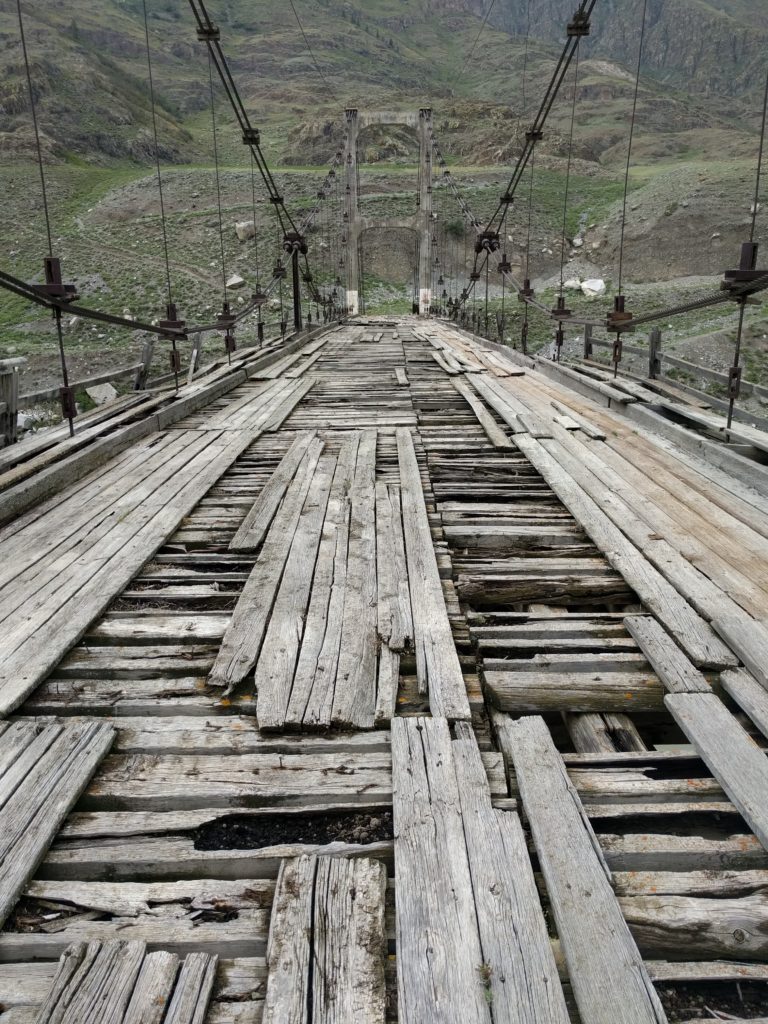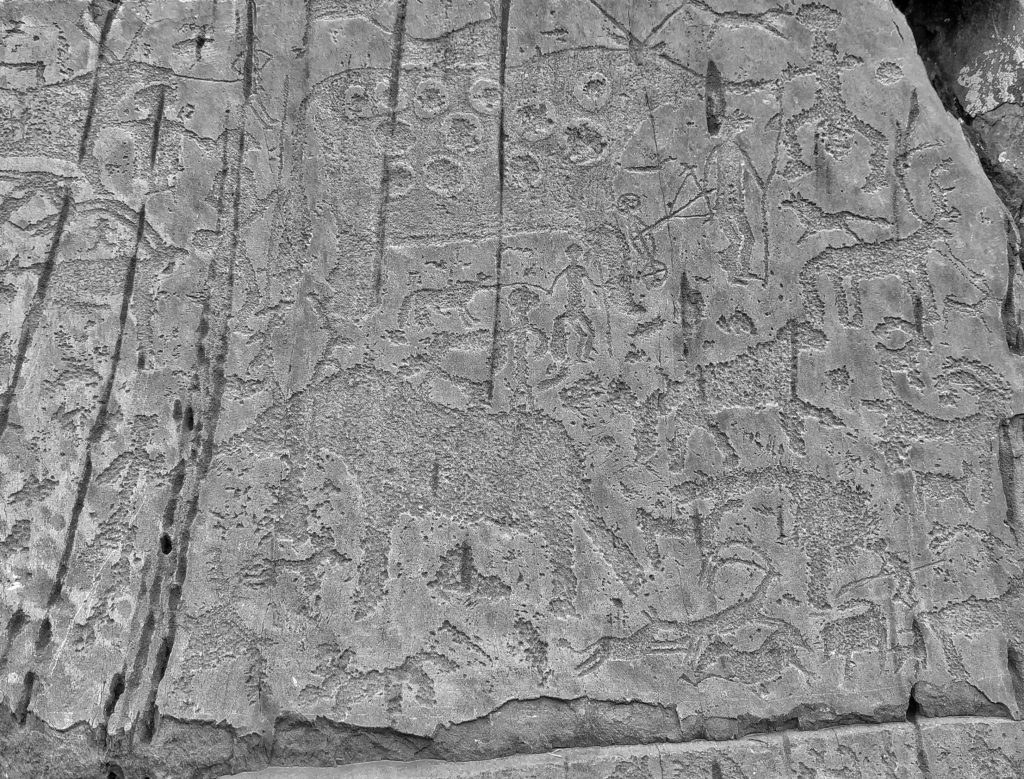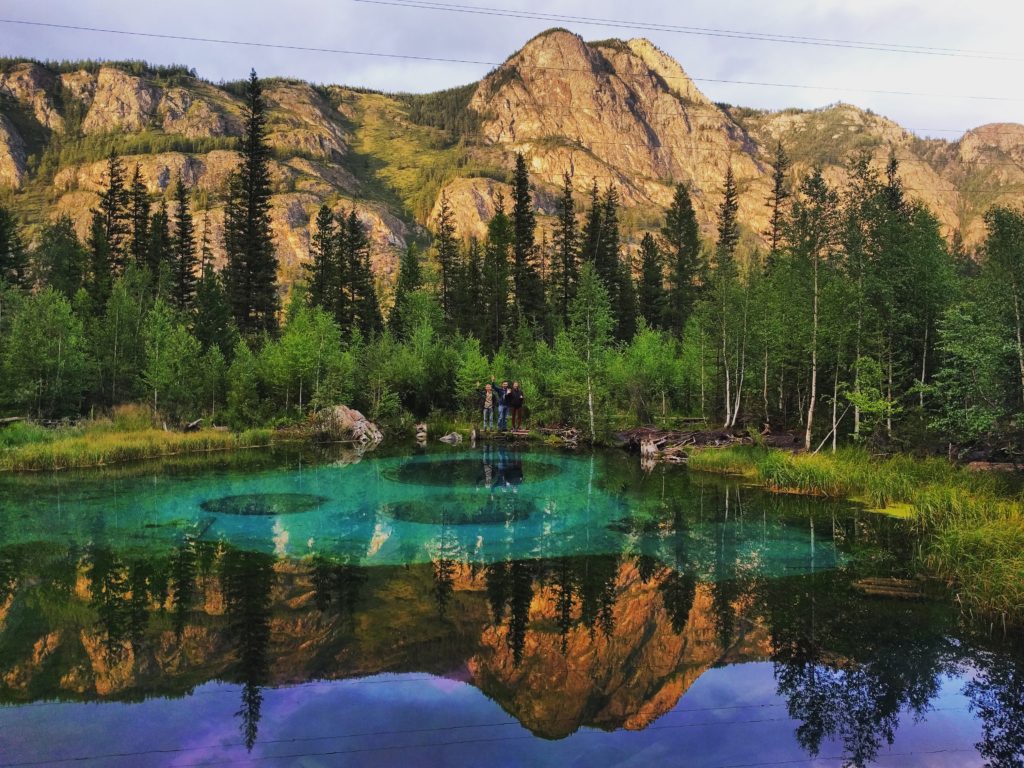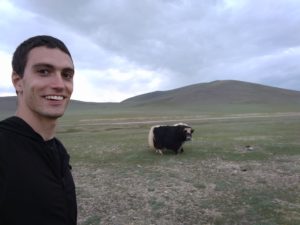For the past week and a half, I have been traveling through the Altai Region. Located near the meeting point of Russia, Mongolia, Kazakhstan, and China, this region is home to one of the most beautiful and remote mountain ranges in the world, as well as vast grasslands and nomadic people who have retained their cultural tradition of hunting with eagles. In this article I will cover my trip to the Russian and Mongolian sections of the Altai Region.
Russian Altai
Getting to the Altai Region is no small ordeal. To arrive in the Russian part of the Altai, I took an overnight train from Novosibirsk to Biisk and then caught a shared taxi from the Biisk train station to Gorno-Altaysk, the capital and largest city in Russia’s Altai Republic province.
In Gorno-Altaysk, I took a quick look at the National Museum of the Altai Republic to get some sense of the culture of Russia’s Altaian ethnic group, who speak their own language at home in addition to Russian. After leaving the museum, I began my journey down the Chuysky Tract, the paved road leading through the Altai Republic to the Mongolian Border. My first course of action was to take one of the Gorno-Altaysk city buses towards the southern end of town, where I would try to hitchhike.
I got off the bus, and after only a couple minutes, I was picked up by a jolly old Russian man in a Soviet-era van. He took me down the road for about 30 minutes until I reached my first stopping point, the Tavdinsky Caves. The area where I was dropped off was actually across the river from the caves and was swarming with Russian tourists going river rafting. It also had a modern looking suspension bridge which I promptly crossed to head to the caves. The caves themselves were a bit of a disappointment as I had been in many more interesting and less touristic caves in the past, but the experience of seeing a typical Russian summer vacation-esque spot nearby made it worth the stop.
Back on the road, I was again picked up fairly quickly. This time it was a Russian couple with a young child, and they were spending the night in a guesthouse in a town called Kamlak down the road about 15 minutes. After exiting their car at the guesthouse, I leisurely strolled through the town as the sun was setting and observed the people going about their evening routines.
After about 45 minutes of sticking my thumb towards the road, I caught another ride. The driver was a young man about my own age, and he had a passenger, a young woman, who looked strangely familiar to me, until I realized I had passed her while walking through town. Neither of them spoke a word of English but with my limited Russian I was able to figure out where they were headed. Apparently the guy had come from Omsk and was planning on driving well into the wee hours of the morning to a canyon in a remote area. The girl was just hitchhiking like me and got out of the car at the next town down the road. After driving for about a half hour, we picked up another couple guys, and one of them was from Moscow and spoke English! His name was Ivan.
As we drove onwards for a few hours, dusk turned to night and it started raining. I crossed my fingers that the rain would let up but it just kept getting heavier. Eventually, I decided to leave the car since it was getting quite late and I wanted to set up camp. Ivan and his buddy decided to join me since they had a tent as well, and we found a nice spot to camp across a picturesque old wooden bridge near the town of Inya. After setting up the tents in the rain and getting thoroughly soaked, I took off my wet outer layer and snuggled down into my warm sleeping bag for the night.
In the morning, I woke to a herd of goats outside my tent, and the realization that the rain had let up! I chased the goats off and then set out all of my belongings to dry while chatting with Ivan and going on a short jaunt up a nearby hill.
Since Ivan wanted to spend another night in Inya and I wanted to continue southward, we parted ways and I walked into the ethnic Altai town of Inya, had a quick bite, and checked out some ancient burial stones nearby before hitching my next ride. My next destination was some petroglyphs I had heard about along the road, only a few kilometers further, so I thought the ride would be short.
As it happened, I was picked up by a young English-speaking couple- a Russian guy from Ufa, Andrey, and his Moldovan girlfriend living in St Petersburg, Beatrice. In the car was also a middle aged Russian guy named Alexei and an Altai woman who I never learned the name of. Andrey and Beatrice were taking a road trip to the Russian Altai region in their old Lada (which they had to hotwire when the key stopped working) and had picked up Alexei as a hitchhiker and they were traveling together. There was lively conversation going on in the car and the Altai woman taught us a few words in her language. Since all of us wanted to see the petroglyphs, we decided to stop for a break and take a look before continuing onwards.
Another 15 minutes down the road we dropped the Altai woman off at her home and continued onwards. Little did I know I would be traveling with Andrey and Beatrice for the next few days and we would have lots of good times together.
The next place we stopped was a little geothermal lake called Geyser Lake (Гейзерное Озеро) that Andrey and Beatrice wanted to see. We caught it right at sunset, and the unreal hues of blue and purple in the lake contrasted well with the reddening sunlight.
As we continued driving down the road, dusk again approached. We decided to head down a side road near the village of Kuray since I had heard there were nice mountains in the area. It was pitch black and we could see nothing, but after about 30 minutes of driving down a very rough dirt road we reached a bridge over a river and decided to set up camp.
In the morning, I was the first one up. Upon looking out of the tent, I was shocked. Before me stood a vast pararie with glaciated mountains rising up into the sky. It was a beautiful, sunny day, and I couldn’t ask for anything more. Beatrice was up next and it was the first time in her life she had seen snowy mountains, and she went berserk.
Since Beatrice and Andrey were Seventh-Day Adventists, we all celebrated the Sabbath together by relaxing and taking in the view. Alexei wanted to go back to Inya to explore the town and Altai culture some more, so he started walking back to the main road to hitchhike back.
In the evening, thunderstorms started to approach so we quickly packed up and started driving onwards. We made it a couple more hours down the road to the town Kosh-Agach, passing a herd of camels on the way. In Kosh-Agach we spent the night at a small guesthouse where we met an English cyclist also named Josh along with his American friend. Josh was traveling from England to Mongolia by bicycle through the Central Asian countries. He had already been on the road for over a year, leaving England in May 2017, about the same time I left my job in Seattle to travel. Josh and his friend were the only other foreigners I met the entire time I was in the Russian Altai region, unless you count Beatrice since she was originally from Moldova.
The next day Andrey, Beatrice, and I backtracked a bit to head to a location called “Mars” which we had passed the evening before. It consisted of some brightly colored hills and a viewpoint of some surrounding mountains. We relaxed there for several hours, and then headed onwards to the Mongolian border town, Tashanta. Unfortunately, the car overheated on the way, and we found out that all of the antifreeze had leaked out of the radiator! Thankfully I had enough knowledge about car engines to figure this out, and we put some water into the radiator to help the car cool down as we made our way to Tashanta. A funny note- turns out a local wedding party was passing by and the groomsmen stopped and asked if we needed help, right in the middle of their wedding!
On the way to Tashanta we were treated to a spectacular show of night thunderstorms, and unexpectedly ran into a couple of hitchhikers huddling in the rain. We picked them up only to find out they were Josh and his friend, who had abandoned their tents out of fear for their safety in the intense thunderstorms. We all headed onwards to Tashanta and got a 5 person room at a hotel in town.
In the morning we woke up and I parted ways with everyone. At the border I was approached by two guys, an Israeli named Edo and a Kazakh named Arman, and offered a ride across the border. They were both leaving and re-entering Mongolia to reset the clock on their time allowed in Mongolia, and they caught me in the middle.
We crossed through Russian immigration quite quickly and drove in no-man’s-land for 20-30 minutes until the Mongolian border post. Unfortunately their computer system was down that day so we were stuck in no man’s land for another 6 hours! However, the weather was nice and the surroundings were beautiful so I sat outside, picnicked, and read.
Mongolian Altai
Once we made it into Mongolia, Arman drove Edo and I to Edo’s hotel in Ulgii and I got a room there for cheap.
The province that Ulgii is in (Bayan-Olgii, Mongolia) is majority ethnic Kazakh and everyone speaks Kazakh. In addition, Kosh-Agach and areas around it in the far south of the Altai Republic of Russia are also majority ethnic Kazakh people.
Edo and his friend Allel were headed to a small town called Deluun the next day and planned to trek there into the mountains nearby. I decided to join them and we went to the local bazaar, called the Black Market, in Ulgii to try and find a ride in a shared van. Eventually we found someone after asking around with Google Translate in Kazakh.
During the four hour ride in the shared van, it was getting dusty and a girl asked me to close the window in English. A bit surprised, I turned around and started talking to her. I found our her name was Dina and she was from Astana, Kazakstan. Between her broken English and my broken Russian we talked for the rest of the ride, and she invited me to stay in the yurt of some of her family members in Deluun. I gladly accepted, and the Israelis decided to abandon their plan of trekking in he mountains and join as well. Over the course of the next four days, we hung out with the family, played with their children, and took in the authentic Kazakh lifestyle.
The second day, we went to the river to go swimming and wash their family car. In the evening, we found out that the reason why Dina was in town was because her best friend was getting married and she was the maid of honor! She invited us to the wedding and of course we went and had a blast dancing and eating massive amounts of Kazakh food. Pretty much the whole town of 1,000 people was there, or so it seemed.
Eagle hunting is a big part of Kazakh culture in Mongolia, and Dina asked if we wanted to meet one of her relatives who was an eagle hunter and lived out of town by a lake around 40 kilometers away. Again, we accepted the offer and drove with the family to the lake and spent the day climbing mountains and picking berries. In the evening we went to find the alleged eagle hunter. To our disappointment, he was gone, but his son was at the yurt and showed us the eagles and how to handle them. I got a chance to hold one of the eagles myself, which was pretty neat.
Afterwards we visited some more of Dina’s relatives on the way back to Deluun and ate dinner in their yurt. Unfortunately I got sick that evening from food poisoning but it passed quickly and I rested and felt better by the end of the following day.
Going back to Ulgii from Deluun was a sad affair- we had to say bye to the family that had so generously hosted us for so long. We gave them plenty of gifts we brought (balloons, a coloring book, and cash for the expenses of hosting us, among other things) and waved goodbye. Dina was also headed back at the same time so we caught the shared van with her and had the same driver as before (he is probably the only driver on the route).
Arriving back in Ulgii I did some research on transportation to Kazakhstan and now I am relaxing at my hotel and writing this post. Hope you enjoyed reading about my adventure! If you plan to travel to these areas, check out the information below.

Animals crossing the road is a common occurrence in the Altai Region. Here are a herd of horses crossing.
Additional Information and Costs for Prospective Travelers
- The overnight train from Novosibirsk to Biisk runs daily and tickets are around $10/600RUB for a seat, $20/1200RUB for 3rd class “platzkart” beds and around $30/1800RUB for 2nd class “kupe” beds. I recommend platzkart for a nice balance of comfort and cost.
- The shared taxi from the Biisk train station to Gorno-Altaysk should cost around $4/250RUB. I paid $8/500RUB but then realized I got ripped off when the other folks in the car were paying the same amount and going more than twice as far to a different city down the road. Shared taxis and buses between the cities run frequently.
- From the bus schedule in Gorno-Altaysk, it looked like the farthest it was possible to go by bus towards Mongolia was to the town of Onguday, with 2 buses per day. However, when I tried to buy a ticket a half hour before, it was sold out.
- Hitchhikers in both Russia and Mongolia are expected to pay a small amount to help with gas costs- budget paying about $2 per hour you are in the car. However, in every case when I offered money, it was rejected since the people were so kind. Also, a few words of Russian can go a long way. I would suggest learning some words to describe where you want to go (e.g. еду/yedu).
- Some tourist spots like the petroglyphs near Inya have a small entrance fee of 50-200RUB/$1-3 per person.
- Budget hotel room costs in the Altai region (both Russia and Mongolia) are around $5-10 per person if you are with other people and $10-15 for a 1 person room to yourself. Hostels are scarce to non-existent. I would recommend camping though since there is a lot of natural beauty, or in Mongolia staying in a yurt with a family.
- The border crossing between Russia and Mongolia (Tashanta to Tsanaagur) normally takes around 3 hours in either direction, maybe more or less. It is open to foreigners. It is open from around 8 or 9 AM to 8 or 9 PM, except Sundays when it is closed. You must be in a car or on a motorbike or bicycle to cross the border. There is a 20-30 minute drive between the Russian immigration post and the Mongolian immigration post, with another minor Russian checkpoint in the middle. 10000MNT/250RUB/$4 is the going rate for being taken across by a driver. Walk to the front of the line before getting in a car so that you can skip the wait, if possible.
Normally a ride from the border to Ulgii costs 15000MNT/$6 more but I was offered it for free by Arman. - The trip from Ulgii to Deluun costs 15000-20000MNT/$6-8 each way. For trips to other areas in shared vans you can budget around $2 per hour of driving.
- Permits to Tavan Bogd National Park can be arranged for $10 through Blue Wolf Travel in Ulgii and they need a day to process your permit and a copy of your main passport page. Russian and China border area permits do not seem to be needed if you are with a guide as the travel agencies do not get them for tourists. If you are without a guide, the Russian border permit is available in Tsanaagur village between the border and Ulgii, and the Chinese border permit is available in Ulgii itself. Both are free or low cost.
- Hiring a local car and its driver from Blue Wolf Travel costs around $55 per day that the car is moving and $40 per day that it is not moving, plus the cost of gas (as of July 2018 it is $60 for gas to Tavan Bogd and back). The car can hold up to 4 travelers. Hiring an English speaking guide will cost $40 per day as well plus the cost of meals for the guide. With 1 person this option is quite expensive (I did not do it) but if you meet 3 other travelers the cost is more reasonable. The staff at Blue Wolf Travel are also very nice.
- If staying with a local family, give them 10000-20000MNT/$4-8 USD per night you stay, or the equivalent in gifts or useful items. If you are not in a touristic area they will not ask for it and maybe refuse at first, but the families are very poor and can definitely use the help. Gifts are probably more appropriate than money, except in touristic areas where money is expected.
- Shared vans and occasionally buses depart to Kazakhstan (through Russia) from Ulgii every day, except Sunday since the Tsanaagur-Tashanta border is closed. These vans/buses are hard or impossible to catch in the middle of their routes (e.g. Kosh-Agach) since they are often full. It is possible to catch either a van or a bus to Almaty, Astana, Pavlodar, or Oskemen nearly every day, at least in the summer. They all leave around 6 or 7 AM and you need to go to a parking lot on the south side of Ulgii just south of the “Mongolian Turkish School” on Google Maps the day before to reserve a spot and ask where the meeting spot is the following morning (probably the south side of the only bridge over the river). The going rate as of July 2018 for a bus to Almaty is 130,000MNT/52USD and a van is 150,000MNT/60USD. For Astana a bus is 80,000MNT/32USD and a van is 100,000 MNT/40USD. For Oskemen a van is about 70,000-80,000MNT/28-32USD. For Pavlodar a bus or van can drop you off on the way to Astana for slightly less. I recommend taking buses if they are available since I heard they have a fast lane at immigration.
Note that Americans do not need a visa for Mongolia or Kazakhstan but do need one for Russia. A three year multiple entry visa to Russia can be obtained in advance through your closest Russian embassy or consulate for around $300. Single or double entry visas are available for less.
Hope this information helps, it seems more comprehensive than I could find elsewhere on the internet. Safe travels!
















